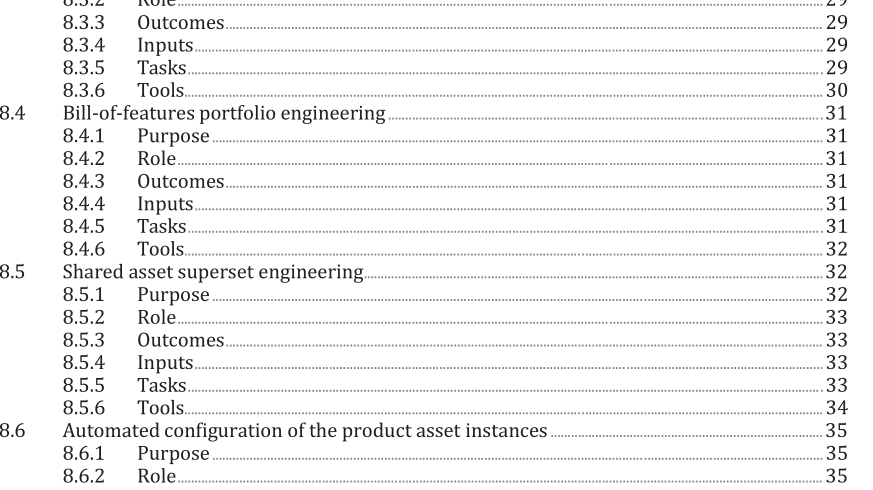ISO IEC 26580-2021 pdf Software and systems engineering — Methods and tools for the feature- based approach to software and systems product line engineering

3 Terms and definitions For the purposes of this document, the terms and definitions given in ISO/IEC/IEEE 12207, ISO/IEC/IEEE 15288, and the following apply. ISO and IEC maintain terminological databases for use in standardization at the following addresses: — ISO Online browsing platform: available at https://www.iso .org/obp — IEC Electropedia: available at http://www.electropedia .org/ NOTE 1 For additional terms and definitions in the field of systems and software engineering, see ISO/IEC/IEEE 24765, which is published periodically as a “snapshot ” of the SEVOCAB (Systems and software engineering – Vocabulary) database and is publicly accessible at www.computer.org/sevocab. NOTE 2 Because feature-based PLE is a specialization of the more general product line engineering approach described in ISO/IEC 26550, some of the terminology used herein is noted as a specialization of the terminology from ISO/IEC 26550, with further details provided in Annex A . 3.1 bill-of-features specification for a member product (3.8) in the product line (3.16), rendered in terms of the specific features (3.4) from the feature catalogue (3.5) that are chosen for that member product 3.2 bill-of-features portfolio collection comprising the bill-of-features (3.1) for each member product (3.8) in a product line (3.16) 3.3 domain supersets collection comprising the feature catalogue ( 3.5 ) and shared asset supersets (3.18) 3.4 feature characteristic of a member product (3.8) in a product line (3.16) that distinguishes it from other member products in the product line Note 1 to entry: Features can a) express the customer-visible or end-user-visible variability among the member products in a product line, or b) distinguish implementation variability not directly visible to a customer or end user except through non-functional differences such as price, performance, noise, weight, energy and more.
4.1 General This clause gives a brief informational overview of feature-based product line engineering, as a way of introducing key concepts that are important for understanding the purpose and content of this document. Software and systems product line engineering emerged some time ago as way to engineer a portfolio of related products in an efficient manner, taking full advantage of the products ’ similarities while respecting and managing their differences. Here “engineer ” means all of the activities involved in planning, producing, delivering, deploying, sustaining, and retiring products. Born in the software engineering field in the 1970s and 1980s and based largely on the concept of software reuse, PLE has long been known for delivering significant improvements in development time, cost, and quality of products in a product line .
- ISO IEC 27050-4-2021 pdf Information technology — Electronic discovery — Part 4: Technical readiness
- ISO IEC 27036-1-2021 pdf Cybersecurity — Supplier relationships — Part 1: Overview and concepts
- ISO IEC 27013-2021 pdf Information security, cybersecurity and privacy protection — Guidance on the integrated implementation of ISO/IEC 27001 and ISO/IEC 20000-1
- ISO IEC 24735-2021 pdf Information technology — Office equipment — Method for measuring digital copying productivity
- ISO IEC 24711-2021 pdf Information technology — Office equipment — Method for the determination of ink cartridge yield for colour inkjet printers and multi- function devices that contain printer components
- ISO IEC 23544-2021 pdf Information Technology — Data centres — Application Platform Energy Effectiveness (APEE)
- ISO IEC 23510-2021 pdf Information technology — 3D printing and scanning — Framework for an Additive Manufacturing Service Platform (AMSP)
- ISO IEC 23127-1-2021 pdf Information technology — Learning, education, and training — Metadata for facilitators of online learning — Part 1: Framework
- ISO IEC 23126-2021 pdf Information technology for learning, education and training — Ubiquitous learning resource organization and description framework
- ISO IEC 21838-2-2021 pdf Information technology — Top-level ontologies (TLO) — Part 2: Basic Formal Ontology (BFO)
- IEC 62787-2021 pdf Concentrator photovoltaic (CPV) solar cells and cell on carrier (CoC) assemblies – qualification
- IEC 63002-2021 pdf Interoperability specifications and communication method for external power supplies used with computing and consumer electronics devices
- IEC 60317-37-2013 pdf Specifications for particular types of winding wires – Part 37: Polyesterimide enamelled round copper wire, class 180, with a bonding layer
- ISO IEC 23544-2021 pdf Information Technology — Data centres — Application Platform Energy Effectiveness (APEE)
- IEC 60243-2-2013 pdf Electric strength of insulating materials – Test methods – Part 2: Additional requirements for tests using direct voltage
- BS ISO IEC 15420-2009 pdf Information technology一 Automatic identification and data capture techniques EAN/UPC bar code symbology specification
- BS IEC 60860-2014 pdf Radiation protection instrumentation一 Warning equipment for criticality accidents
- BS ISO IEC 19762.5-2008 pdf Information technology一 Automatic identification and data capture (AIDC) techniques – Harmonized vocabulary Part 5: Locating systems
- ISO IEC 24711-2021 pdf Information technology — Office equipment — Method for the determination of ink cartridge yield for colour inkjet printers and multi- function devices that contain printer components
- ISO IEC 24735-2021 pdf Information technology — Office equipment — Method for measuring digital copying productivity